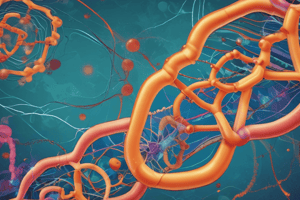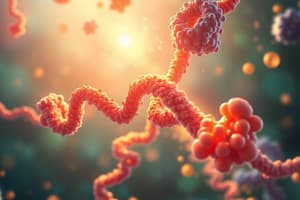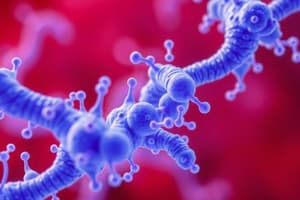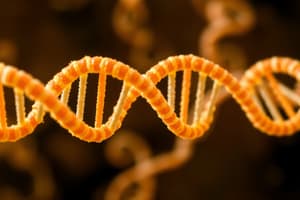Podcast
Questions and Answers
What distinguishes prokaryotic mRNA from eukaryotic mRNA?
What distinguishes prokaryotic mRNA from eukaryotic mRNA?
- Prokaryotic mRNA is always monocistronic.
- Eukaryotic mRNA has a longer half-life.
- Prokaryotic mRNA is often polycistronic. (correct)
- Eukaryotic mRNA is synthesized in the cytoplasm.
Where does transcription take place in eukaryotic cells?
Where does transcription take place in eukaryotic cells?
- In the mitochondria
- In the cytoplasm
- In the chloroplast
- In the nucleus (correct)
Which of the following is a key player in both transcription and translation?
Which of the following is a key player in both transcription and translation?
- RNA Polymerase
- Promoters
- mRNA (correct)
- Ribosomes
What is one of the main roles of transcription factors?
What is one of the main roles of transcription factors?
Which of the following statements about translation is true?
Which of the following statements about translation is true?
What is the role of RNA polymerase in transcription?
What is the role of RNA polymerase in transcription?
How is mRNA processed in eukaryotic cells before it exits the nucleus?
How is mRNA processed in eukaryotic cells before it exits the nucleus?
What signifies the end of the translation process?
What signifies the end of the translation process?
Which statement about the genetic code is correct?
Which statement about the genetic code is correct?
Which component of translation carries amino acids to the ribosome?
Which component of translation carries amino acids to the ribosome?
In which direction is mRNA synthesized during transcription?
In which direction is mRNA synthesized during transcription?
What is the primary function of the ribosome in translation?
What is the primary function of the ribosome in translation?
What is a characteristic of prokaryotic transcription compared to eukaryotic transcription?
What is a characteristic of prokaryotic transcription compared to eukaryotic transcription?
Flashcards
Prokaryotic Transcription and Translation
Prokaryotic Transcription and Translation
Prokaryotes make proteins in one location: the cytoplasm. They have no nucleus, so transcription and translation happen at the same time.
Eukaryotic Transcription and Translation
Eukaryotic Transcription and Translation
Eukaryotic cells have a nucleus where DNA is stored. Transcription occurs in the nucleus, and then the mRNA travels to the cytoplasm for translation.
Eukaryotic mRNA Processing
Eukaryotic mRNA Processing
Before a eukaryotic mRNA molecule can be translated into a protein, it undergoes processing, including adding a cap, removing non-coding regions (splicing), and adding a tail. This ensures the mRNA is stable and functional.
Polycistronic mRNA
Polycistronic mRNA
Signup and view all the flashcards
Monocistronic mRNA
Monocistronic mRNA
Signup and view all the flashcards
Transcription
Transcription
Signup and view all the flashcards
Translation
Translation
Signup and view all the flashcards
Promoter
Promoter
Signup and view all the flashcards
Enhancer
Enhancer
Signup and view all the flashcards
RNA polymerase
RNA polymerase
Signup and view all the flashcards
Introns
Introns
Signup and view all the flashcards
Exons
Exons
Signup and view all the flashcards
Transfer RNA (tRNA)
Transfer RNA (tRNA)
Signup and view all the flashcards
Study Notes
Introduction to Transcription and Translation
- Transcription is the process of copying a segment of DNA into RNA.
- Translation is the process of decoding the RNA sequence into a specific amino acid sequence, forming a polypeptide chain (protein).
- These two processes are fundamental to gene expression, enabling cells to synthesize proteins from the instructions encoded in DNA.
- The processes are highly regulated to ensure appropriate protein synthesis.
Transcription
- DNA serves as the template for mRNA synthesis.
- Specific regions on DNA, including promoters and enhancers, are involved.
- RNA polymerase is the enzyme responsible for synthesizing mRNA.
- The enzyme binds to the promoter region of the DNA, initiating transcription.
- The sequence of bases in the DNA template is copied into a complementary sequence in the mRNA.
- Uracil (U) replaces thymine (T) in mRNA.
- The mRNA molecule is synthesized in the 5' to 3' direction.
- Eukaryotic transcription is more complex than prokaryotic, involving additional steps and regulatory factors.
- mRNA is processed before leaving the nucleus in eukaryotes.
- Introns are removed, and exons are joined together to form a mature mRNA molecule.
- This mature mRNA carries the genetic code from the DNA to the ribosomes in the cytoplasm.
Translation
- Translation occurs in the cytoplasm where ribosomes are located.
- mRNA carries the genetic code from DNA.
- Transfer RNA (tRNA) molecules bring amino acids to the ribosome.
- Each tRNA molecule has an anticodon that is complementary to a specific codon on the mRNA.
- The ribosome reads the mRNA codon sequence.
- Each mRNA codon corresponds to an amino acid.
- tRNAs deliver the appropriate amino acid to the ribosome.
- Peptide bonds form between adjacent amino acids, building the polypeptide chain.
- The polypeptide chain continues to grow until a stop codon is reached on the mRNA.
- A release factor binds to the stop codon, causing the ribosome to release the polypeptide.
- The polypeptide folds into a functional protein.
Genetic Code
- The genetic code is universal, meaning the same codons code for the same amino acids in almost all organisms.
- The genetic code is degenerate; multiple codons can code for the same amino acid.
- There are three stop codons, which signal the end of translation.
- The genetic code is non-overlapping, meaning a base is only read once.
Differences between Prokaryotic and Eukaryotic Transcription and Translation
- Prokaryotic transcription and translation occur simultaneously in the cytoplasm.
- Eukaryotic transcription takes place in the nucleus, while translation occurs in the cytoplasm.
- Eukaryotic mRNA is processed (capping, splicing, polyadenylation) before translation.
- Prokaryotic mRNA is often polycistronic, encoding multiple proteins, while eukaryotic mRNA usually encodes a single protein.
Key Players in Transcription
- RNA Polymerase (initiates synthesis)
- Promoters (regions where transcription begins)
- Enhancers (regulatory regions that promote transcription)
- Transcription Factors (proteins that bind to promoters and enhancers)
Key Players in Translation
- Ribosomes (facilitate polypeptide synthesis)
- Transfer RNA (tRNA) (brings amino acids)
- mRNA (carries genetic code)
Studying That Suits You
Use AI to generate personalized quizzes and flashcards to suit your learning preferences.




